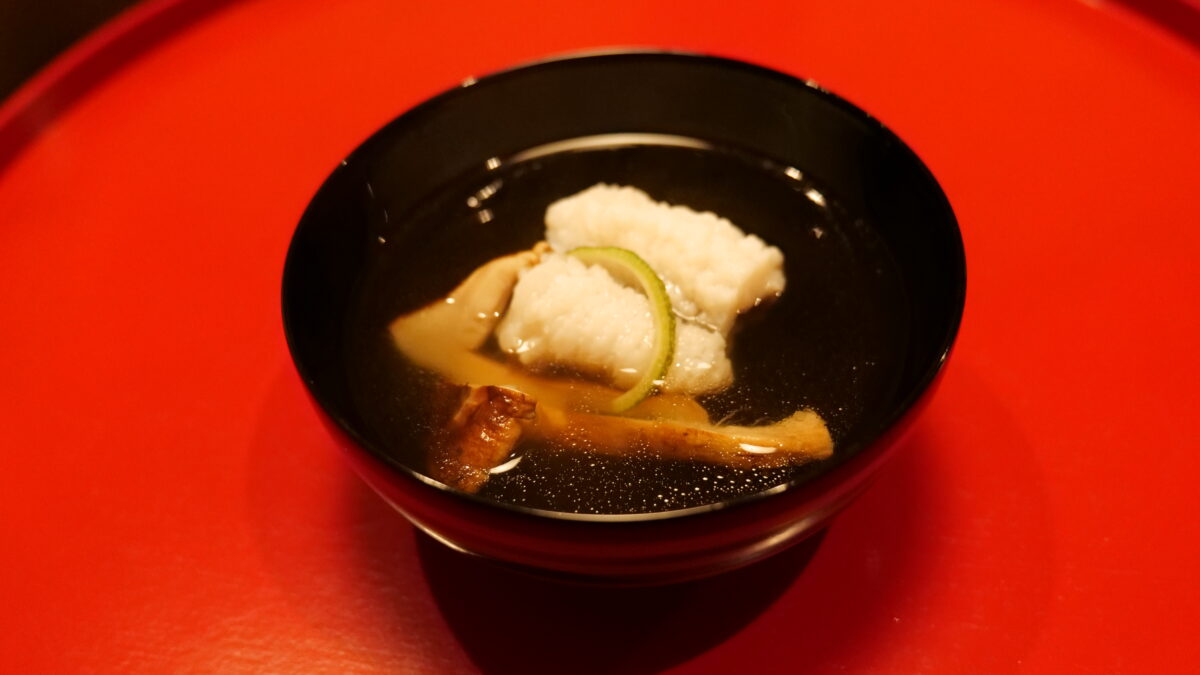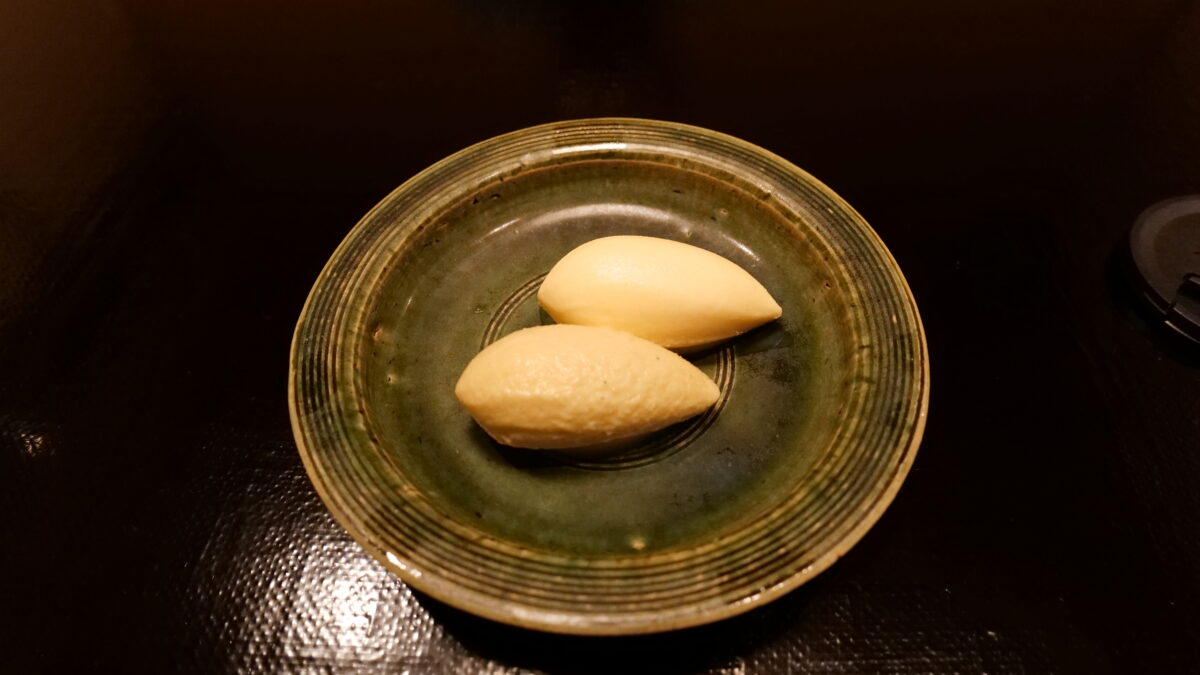For dinner, our culinary journey commenced with an aperitif of Shuzenji’s locally brewed sake—a dry, refreshing elixir that was exceptionally smooth and palatable.
Ginkgo and scallops.
The opening dish featured a sublime pairing of ginkgo and scallops, introducing us to the meal with the scallops’ simple yet perfectly seasoned flavors. As we dined within the privacy of our room, our Nakai-san (attendant) meticulously explained each dish with a grace and eloquence that spoke volumes of the high standards upheld by Asaba’s staff. Her tone and volume were notably pleasant, adding an extra layer of enjoyment to our dining experience. One particularly memorable aspect was her engaging manner; maintaining eye contact throughout our conversation and respectfully lowering his gaze upon conclusion, her laughter even carried an air of refinement. It was a testament to his natural demeanor and her conscientious representation of the ryokan’s ethos.
Ikura (salmon roe) that seems to be homemade. (left)
It was delightfully moist and flavorful with just the right touch of saltiness.
Saikyo pickled Manganese pork (center)
its fatty meat offering a crispy yet tender bite, enjoyable even when cooled, and peculiarly satisfying.
Kinukatsugi (right)
This dish carefully expresses the original taste of potatoes made from small Ishikawa potatoes. The texture of the sticky sweet potato keeps its flavor for a long time.
Hamo (Japanese conger eel) and matsutake mushroom arms
A dish of Hamo (Japanese conger eel) and matsutake mushrooms was presented in a modern adaptation, served individually rather than in a communal pot—a reflection of contemporary dining norms. The hamo, seasoned to perfection, revealed its succulent fat upon tasting, making for an exceptionally delicious experience. The broth, adorned with a hint of hamo fat and the aroma of matsutake mushrooms, was nothing short of a culinary masterpiece, even though the mushrooms hailed from China.
Local fish sashimi: bluefin squid, flatfish, and sweet shrimp
The sashimi course featured local bluefin squid, flatfish, and sweet shrimp, served with freshly grated wasabi and salt. Each element was expertly aged and prepared, revealing the depth of flavors and textures—from the squid’s sweet tenderness to the flatfish’s fatty richness and the innovative preparation of the amaebi (sweet shrimp).
Anago Black Rice Sushi
Anago Black Rice Sushi, a traditional dish of Asaba, impressed with its centuries-old legacy. The ancient black rice provided a unique chewy and crunchy texture, complemented by the softly glazed conger eel, with a hidden layer of sansho (Japanese pepper) leaves adding a subtle, intriguing spice.
Amagi Gundori Charcoal Grilled Chicken
The Amagi Gundori Charcoal Grilled Chicken surprised us with its perfectly grilled leeks, offering a consistent softness and sweetness throughout. The assortment of chicken parts—thigh, breast, and liver—allowed us to savor the distinctive flavors and textures, with the liver being notably devoid of any blood scent, enhanced by a touch of original shichimi (seven spices).
Vinegared lotus root, bok choy, and fu (fu from the Daitokuji temple)
A palate-cleansing dish of vinegared lotus root, bok choy, and fu (wheat gluten from Daitokuji temple) offered a refreshing interlude. The combination of crisp lotus root and fluffy fu in a subtly vinegared Japanese broth created a harmonious blend of flavors and textures.
Deep-fried barracuda arare
Deep-fried barracuda arare showcased the chef’s skill in achieving a perfectly crisp exterior while maintaining the fish’s fluffy interior, a feat of culinary artistry further amplified when dipped in the accompanying garland chrysanthemum starchy sauce.
Orito Eggplant Stew
The Orito Eggplant Stew, featuring eggplants from Shimizu City, Shizuoka Prefecture, was a revelation in texture and flavor, embodying the essence of Japanese broth to perfection and showcasing the chef’s meticulous care in preserving the vegetable’s form.
Matsutake mushroom rice and white sesame miso soup
The main dish of the day, served in a kamado. Koshihikari rice with the flavor of matsutake mushrooms. When Mr. Nakai opened the lid of the kamado, the room was filled with the smell of autumn. Mr. Nakai carefully placed the luxurious takikomi-gohan (rice cooked with only matsutake mushrooms) in a bowl and served it to the guests. The quiet room was filled with noises, but even when placing the bowls on the tray, the waiter served the meal in a beautiful manner, as if by “skill”.
The rice is cooked in a kamado (earthenware pot) so that you can feel every grain of rice in your mouth, and the presence of the matsutake mushrooms adds to this. I was personally very pleased with the small amount of ogee. Taking a breather with some savory dishes and miso soup, the kamado was empty in no time. I was glad to have come at this time of the year…I felt it again.
Desert: melon ice cream with grilled eggplant and ginger.
Our dessert was a choice between melon ice cream, blancmange, and kuzukiri. Opting for the melon, we were then intrigued by the recommended grilled eggplant ice cream—a surprising delight that perfectly captured the essence of grilled eggplant in a sweet, cold treat. The ginger ice cream provided a refreshing finish with its sharp, tangy flavor, rounding off a meal that was a testament to the chefs’ skill and creativity.
We were grateful to our waitress, who was quick to answer any questions we had, and we asked her to pass on our thanks to the chef.
When it was time to lay out the futon, a man in his 70s or so entered the room.
He spread out the pure white sheets with surprising speed that belied his age, and folded the futon perfectly in the corners without wrinkles…it could be called a bed now. The bedding was made up of buckwheat or down pillows, and he accepted our request for two different pillows with a smile. I was overwhelmed by the thickness of the futon, which was almost as thick as some famous beds.
The man had been in charge of bedding for many years with pride. I thought he was a good person, but to my surprise, he even moved his car to the car the next morning for serving and parking. It was smiling in the style of a “chief” who can do anything.
Even before going to bed, he prepared hojicha (roasted green tea), sencha (green tea), and cold water for us, and all services were completed for the day. I felt the professionalism of the staff member who always checks the beverages (tea, etc.), adjusts the room temperature, and takes care of the bedding preference as well as the directions to the salon.
The same man is always at the front door throughout the day.
Throughout our stay, the consistent presence and thoughtful gestures of the staff, from accommodating a smoker’s needs to ensuring a seamless experience, highlighted the exceptional level of service that defines Asaba. Our departure was met with the same attentiveness and grace that greeted our arrival, leaving us with lasting impressions of a stay marked by exquisite culinary delights, unparalleled hospitality, and the serene beauty of Asaba’s surroundings.




















